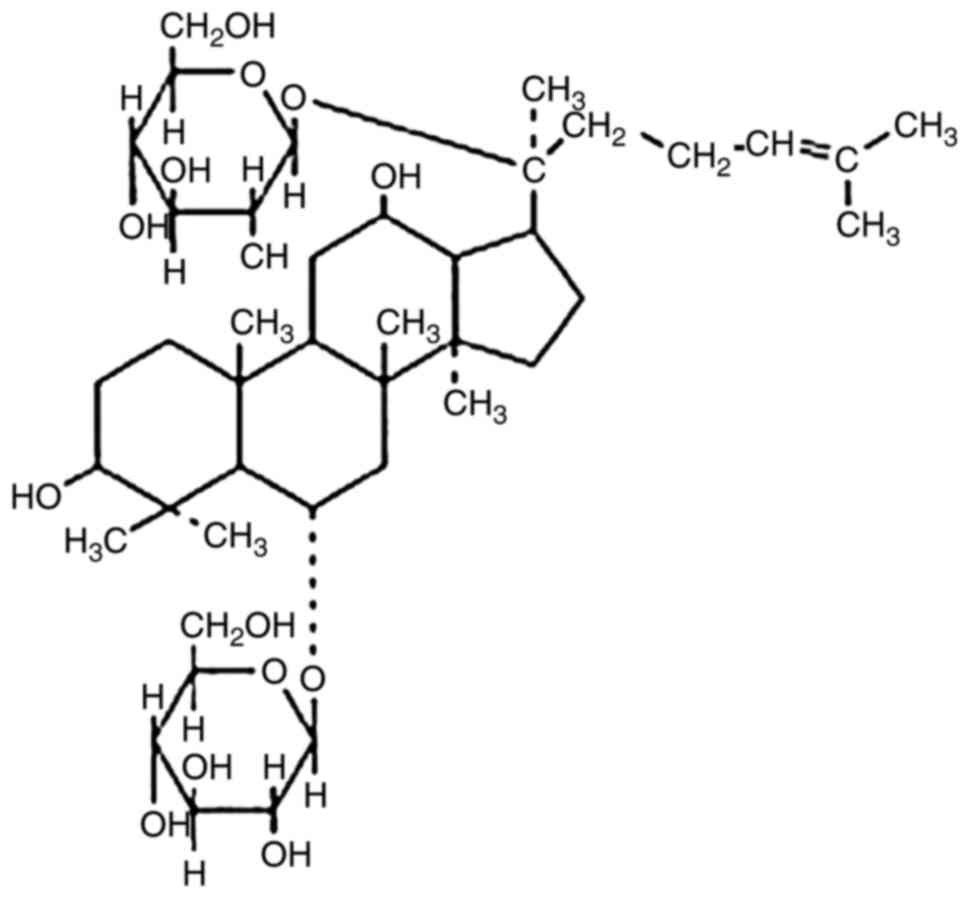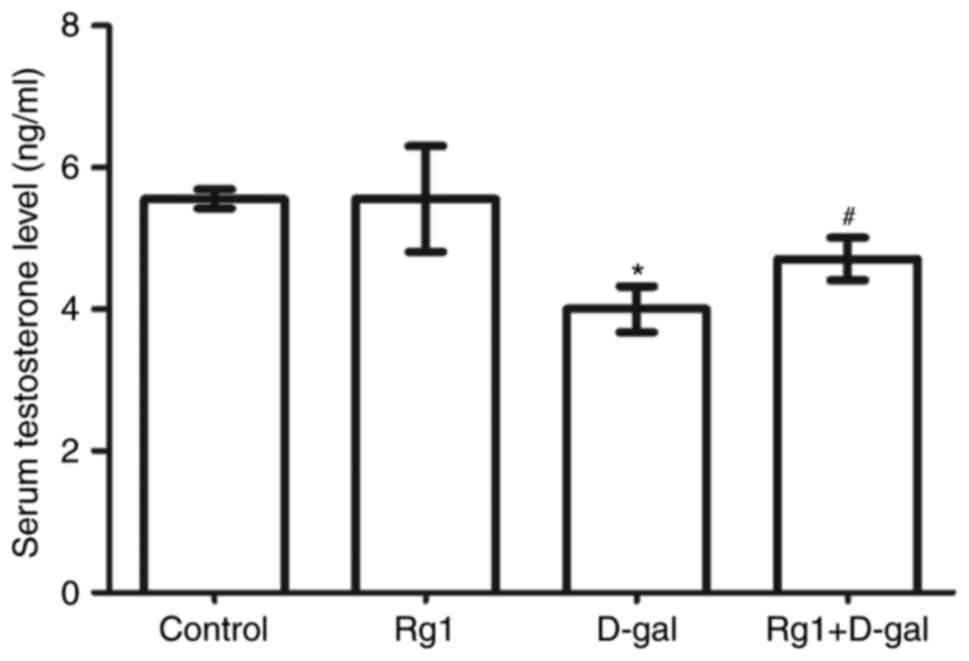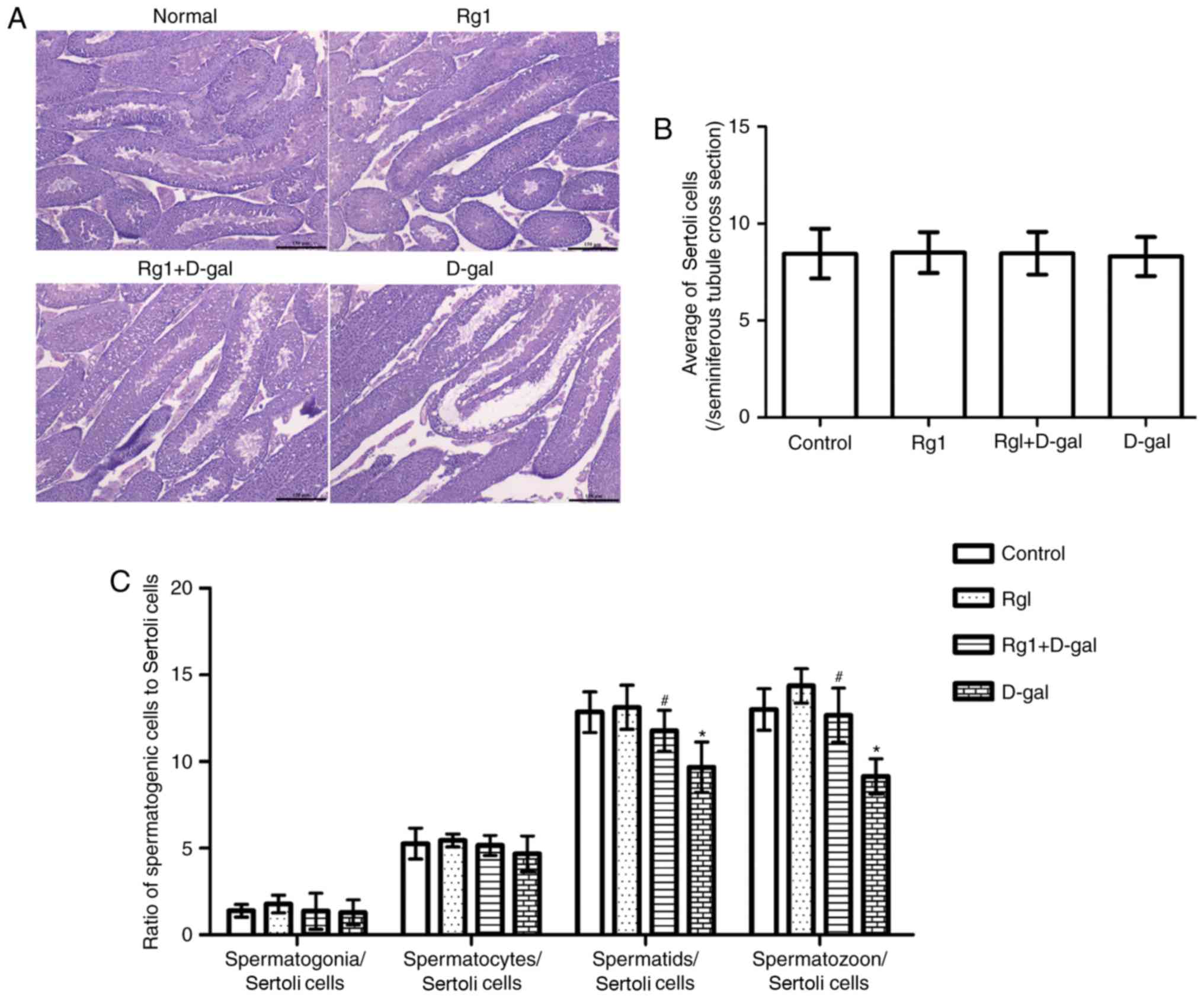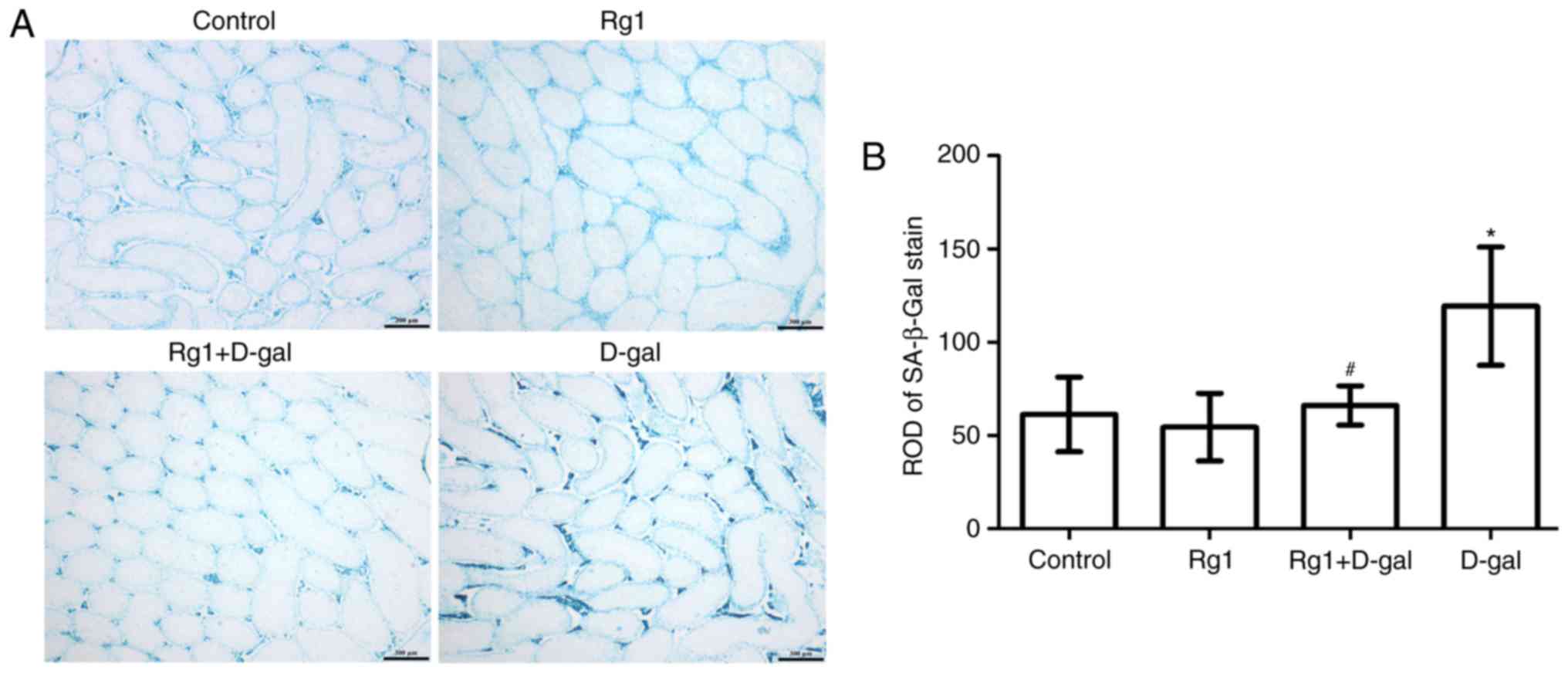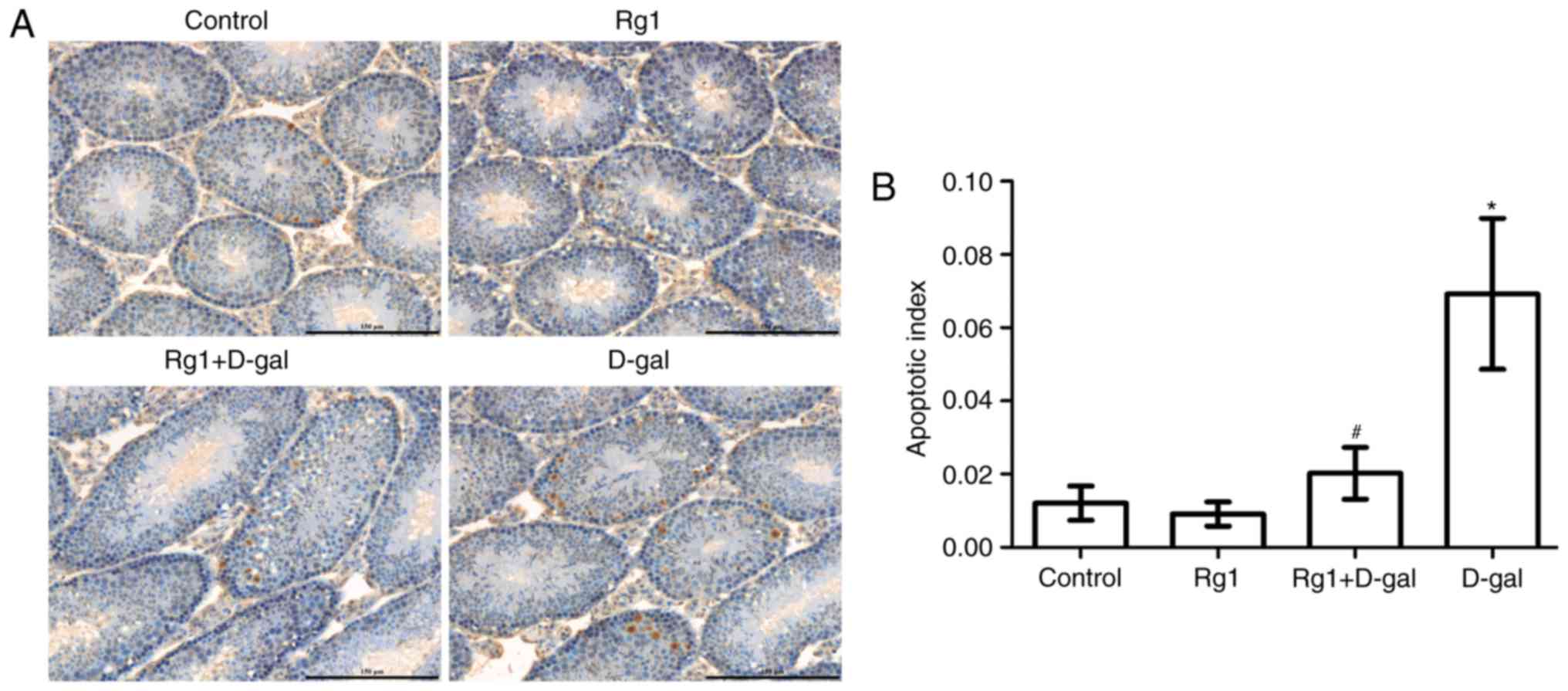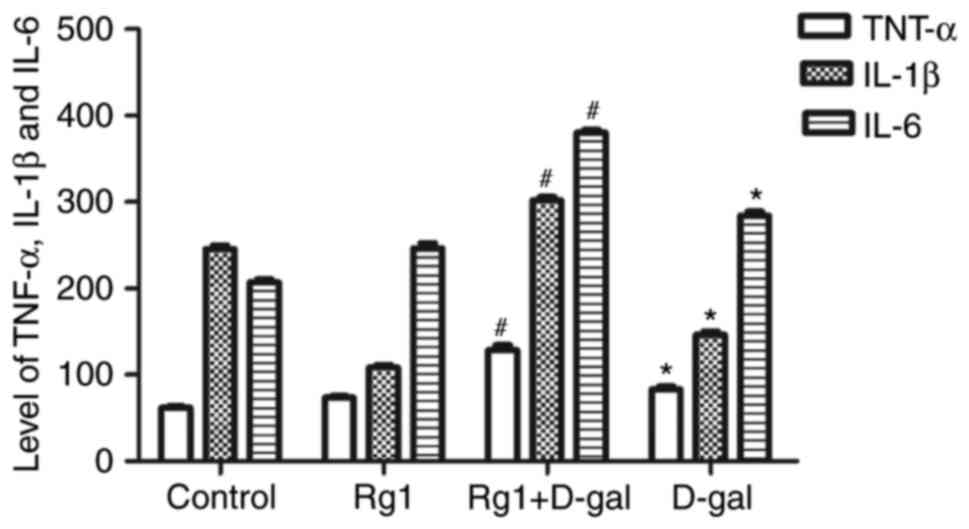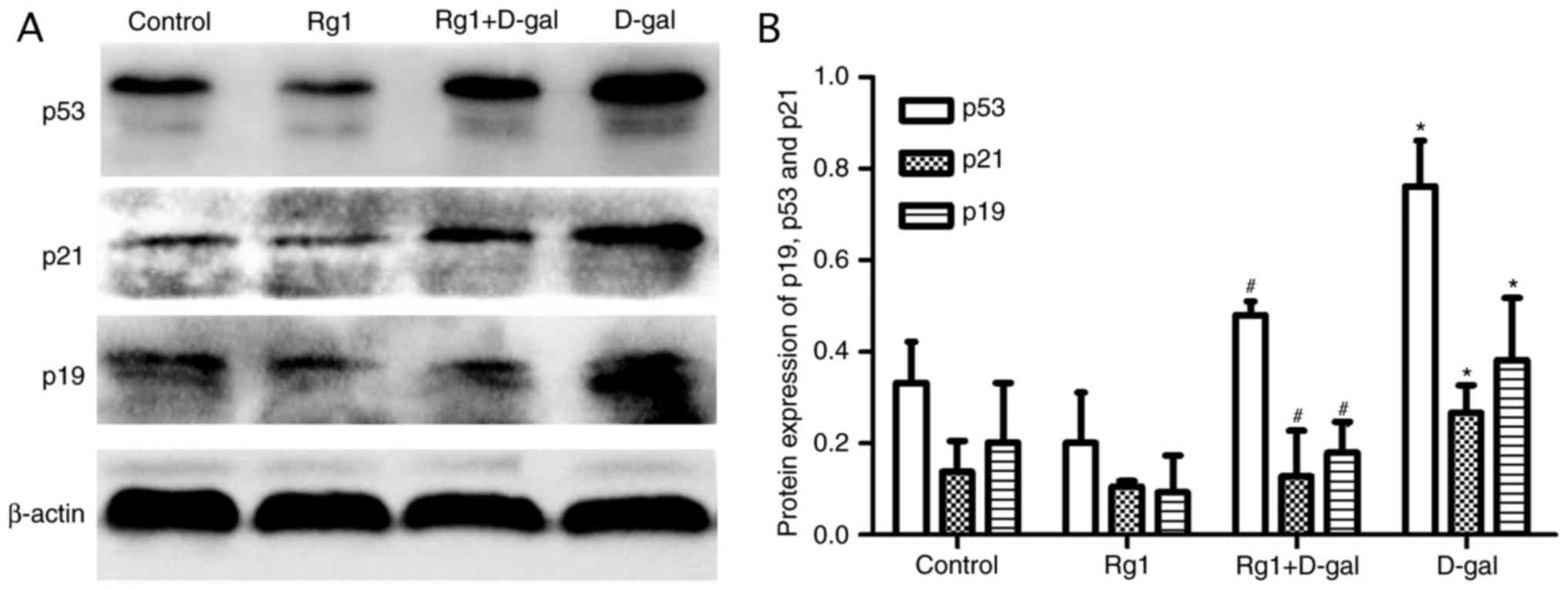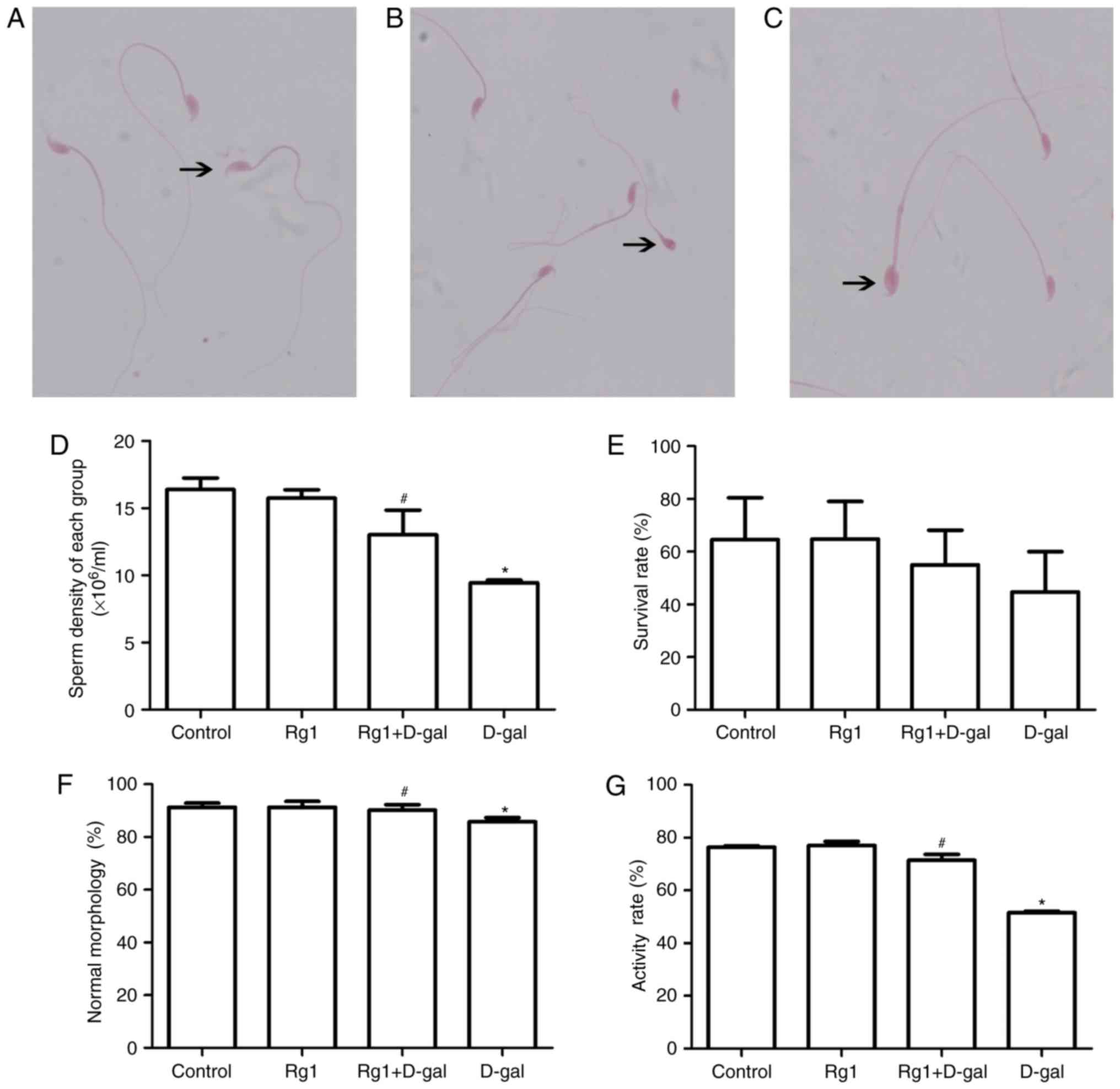|
1
|
Gunes S, Hekim GN, Arslan MA and Asci R:
Effects of aging on the male reproductive system. J Assist Reprod
Genet. 33:441–454. 2016. View Article : Google Scholar : PubMed/NCBI
|
|
2
|
Hu W, Jing P, Wang L, Zhang Y, Yong J and
Wang Y: The positive effects of ginsenoside Rg1 upon the
hematopoietic microenvironment in a D-galactose-induced aged rat
model. BMC Complement Altern Med. 15:1192015. View Article : Google Scholar : PubMed/NCBI
|
|
3
|
Zhou Y, Liu J, Cai S, Liu D, Jiang R and
Wang Y: Protective effects of ginsenoside Rg1 on aging
Sca-1+ hematopoietic cells. Mol Med Rep. 12:3621–3628.
2015. View Article : Google Scholar : PubMed/NCBI
|
|
4
|
Li J, Cai D, Yao X, Zhang Y, Chen L, Jing
P, Wang L and Wang Y: Protective effect of ginsenoside Rg1 on
hematopoietic stem/progenitor cells through attenuating oxidative
stress and the Wnt/β-catenin signaling pathway in a mouse model of
d-galactose-induced aging. Int J Mol Sci. 17:2016.
|
|
5
|
Fan Y, Xia J, Jia D, Zhang M, Zhang Y,
Huang G and Wang Y: Mechanism of ginsenoside Rg1 renal protection
in a mouse model of d-galactose-induced subacute damage. Pharm
Biol. 54:1815–1821. 2016. View Article : Google Scholar : PubMed/NCBI
|
|
6
|
DiLoreto R and Murphy CT: The cell biology
of aging. Mol Biol Cell. 26:4524–4531. 2015. View Article : Google Scholar : PubMed/NCBI
|
|
7
|
Finkel T: The metabolic regulation of
aging. Nat Med. 21:1416–1423. 2015. View
Article : Google Scholar : PubMed/NCBI
|
|
8
|
Rodier F and Campisi J: Four faces of
cellular senescence. J Cell Biol. 192:547–556. 2011. View Article : Google Scholar : PubMed/NCBI
|
|
9
|
Wright WW, Fiore C and Zirkin BR: The
effect of aging on the seminiferous epithelium of the brown Norway
rat. J Androl. 14:110–117. 1993.PubMed/NCBI
|
|
10
|
Cao XW, Lin K, Li CY and Yuan CW: A review
of WHO laboratory manual for the examination and processing of
human semen (5th edition). Zhonghua Nan Ke Xue. 17:1059–1063.
2011.(In Chinese). PubMed/NCBI
|
|
11
|
Dong Z, Xu M, Huang J, Chen L, Xia J, Chen
X, Jiang R, Wang L and Wang Y: The protective effect of Ginsenoside
Rg1 on aging mouse pancreas damage induced by D-galactose. Exp Ther
Med. 14:616–622. 2017. View Article : Google Scholar : PubMed/NCBI
|
|
12
|
Xia JY, Fan YL, Jia DY, Zhang YY, Li J,
Jing PW, Wang L and Wang YP: Protective effect of Angelica sinensis
polysaccharide against liver injury induced by D-galactose in aging
mice and its mechanisms. Zhonghua Gan Zang Bing Za Zhi. 24:214–219.
2016.(In Chinese). PubMed/NCBI
|
|
13
|
Golan R, Scovell JM and Ramasamy R:
Age-related testosterone decline is due to waning of both
testicular and hypothalamic-pituitary function. Aging Male.
18:201–204. 2015. View Article : Google Scholar : PubMed/NCBI
|
|
14
|
Russo SJ, Murrough JW, Han MH, Charney DS
and Nestler EJ: Neurobiology of resilience. Nat Neurosci.
15:1475–1484. 2012. View
Article : Google Scholar : PubMed/NCBI
|
|
15
|
Hsueh AJ, Eisenhauer K, Chun SY, Hsu SY
and Billig H: Gonadal cell apoptosis. Recent Prog Horm Res.
51:433–456. 1996.PubMed/NCBI
|
|
16
|
Wang C, Sinha Hikim AP, Lue YH, Leung A,
Baravarian S and Swerdloff RS: Reproductive aging in the Brown
Norway rat is characterized by accelerated germ cell apoptosis and
is not altered by luteinizing hormone replacement. J Androl.
20:509–518. 1999.PubMed/NCBI
|
|
17
|
Harman D: About ‘Origin and evolution of
the free radical theory of aging: A brief personal history,
1954–2009’. Biogerontology. 10:7832009. View Article : Google Scholar : PubMed/NCBI
|
|
18
|
Brüünsgaard H and Pedersen BK: Age-related
inflammatory cytokines and disease. Immunol Allergy Clin North Am.
23:15–39. 2003. View Article : Google Scholar : PubMed/NCBI
|
|
19
|
Young A: Ageing and physiological
functions. Philos Trans R Soc Lond B Biol Sci. 352:1837–1843. 1997.
View Article : Google Scholar : PubMed/NCBI
|
|
20
|
Yu BP and Chung HY: Adaptive mechanisms to
oxidative stress during aging. Mech Ageing Dev. 127:436–443. 2006.
View Article : Google Scholar : PubMed/NCBI
|
|
21
|
Everitt A and Meites J: Aging and
anti-aging effects of hormones. J Gerontol. 44:B139–B147. 1989.
View Article : Google Scholar : PubMed/NCBI
|
|
22
|
Sakamoto Y, Ichimura T, Tsuruzoe S and
Nakao M: Aging and DNA methylation. Nihon Ronen Igakkai Zasshi.
42:137–143. 2005.(In Japanese). View Article : Google Scholar : PubMed/NCBI
|
|
23
|
Araujo AB, Mohr BA and McKinlay JB:
Changes in sexual function in middle-aged and older men:
Longitudinal data from the Massachusetts Male Aging Study. J Am
Geriatr Soc. 52:1502–1509. 2004. View Article : Google Scholar : PubMed/NCBI
|
|
24
|
Brahem S, Mehdi M, Elghezal H and Saad A:
The effects of male aging on semen quality, sperm DNA fragmentation
and chromosomal abnormalities in an infertile population. J Assist
Reprod Genet. 28:425–432. 2011. View Article : Google Scholar : PubMed/NCBI
|
|
25
|
Gray A, Feldman HA, McKinlay JB and
Longcope C: Age, disease, and changing sex hormone levels in
middle-aged men: Results of the massachusetts male aging study. J
Clin Endocrinol Metab. 73:1016–1025. 1991. View Article : Google Scholar : PubMed/NCBI
|
|
26
|
Lu X, Zhou Y, Wu T and Hao L: Ameliorative
effect of black rice anthocyanin on senescent mice induced by
D-galactose. Food Funct. 5:2892–2897. 2014. View Article : Google Scholar : PubMed/NCBI
|
|
27
|
Van Raamsdonk JM and Hekimi S: Deletion of
the mitochondrial superoxide dismutase sod-2 extends lifespan in
Caenorhabditis elegans. PLoS Genet. 5:e10003612009. View Article : Google Scholar : PubMed/NCBI
|
|
28
|
Liang L, Zhang XH, Ji B, Yao H, Ling XM,
Guo ZJ, Deng HZ and Wu XR: Yifuning postpones ovarian aging through
antioxidant mechanisms and suppression of the Rb/p53 signal
transduction pathway. Mol Med Rep. 14:888–896. 2016. View Article : Google Scholar : PubMed/NCBI
|
|
29
|
Gambino V, De Michele G, Venezia O,
Migliaccio P, Dall'Olio V, Bernard L, Minardi SP, Della Fazia MA,
Bartoli D, Servillo G, et al: Oxidative stress activates a specific
p53 transcriptional response that regulates cellular senescence and
aging. Aging Cell. 12:435–445. 2013. View Article : Google Scholar : PubMed/NCBI
|
|
30
|
Yue Z, Rong J, Ping W, Bing Y, Xin Y, Feng
LD and Yaping W: Gene expression of the p16(INK4a)-Rb and
p19(Arf)-p53-p21(Cip/Waf1) signaling pathways in the regulation of
hematopoietic stem cell aging by ginsenoside Rg1. Genet Mol Res.
13:10086–10096. 2014. View Article : Google Scholar : PubMed/NCBI
|
|
31
|
Itahana K, Dimri G and Campisi J:
Regulation of cellular senescence by p53. Eur J Biochem.
268:2784–2791. 2001. View Article : Google Scholar : PubMed/NCBI
|
|
32
|
Carnero A, Hudson JD, Price CM and Beach
DH: p16INK4A and p19ARF act in overlapping pathways in cellular
immortalization. Nat Cell Biol. 2:148–155. 2000. View Article : Google Scholar : PubMed/NCBI
|
|
33
|
Jacobs JJ, Keblusek P, Robanus-Maandag E,
Kristel P, Lingbeek M, Nederlof PM, van Welsem T, van de Vijver MJ,
Koh EY, Daley GQ and van Lohuizen M: Senescence bypass screen
identifies TBX2, which represses Cdkn2a (p19(ARF)) and is amplified
in a subset of human breast cancers. Nat Genet. 26:291–299. 2000.
View Article : Google Scholar : PubMed/NCBI
|
|
34
|
Fulop T, Witkowski JM, Pawelec G, Alan C
and Larbi A: On the immunological theory of aging. Interdiscip Top
Gerontol. 39:163–176. 2014. View Article : Google Scholar : PubMed/NCBI
|
|
35
|
De la Fuente M and Miquel J: An update of
the oxidation-inflammation theory of aging: The involvement of the
immune system in oxi-inflamm-aging. Curr Pharm Des. 15:3003–3026.
2009. View Article : Google Scholar : PubMed/NCBI
|



